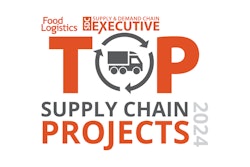
The cold food supply chain is undergoing a transformative phrase with companies responding by leveraging innovative software and technologies to address challenges, increase efficiency and ensure the integrity of perishable goods.
Adoption of these technologies for supply chain visibility is critical for modernizing processes, optimizing logistics, and navigating global supply chain complexities.
A driving factor for the significant changes in which the cold food supply chain is undergoing is that it is grappling with challenges in the wake of the COVID-19 pandemic.
Matt Heerey, president of manufacturing for ECI Software Solutions, indicates its capacity is at 70% of previous levels. He identifies key issues as limited capacity, resource shortages, disrupted material flow, transportation, and logistics problems.
As the industry moves to return to 100%t, “one of the major trends we will continue to see evolve is the integration of robotics and software to streamline repetitive and mundane processes such as packing, sorting and processes,” adds Heerey.
Heerey also emphasized the importance of automation and technology in cold food systems in enhancing inventory management, temperature control, and reducing manual processes.
This not only increases efficiency, but contributes to the quality of perishable goods, he adds.
Glenn Koepke, FourKites’ general manager of network collaboration, notes one trend in the cold food chain is the use of sophisticated artificial intelligence (AI) and machine learning (ML) engines for accurate forecasting, addressing growing season challenges, capacity allocations, distribution, and order demand.
The adoption of AI- and ML-based tracking to collaborate with third-party logistics (3PL) providers, temp control carriers and the end customer grows each quarter, he adds.
Another trend: companies are faced with legacy technical debt from acquisitions and/or a lack of investment in overall infrastructure, Koepke says, adding many cold food chains start with farmers in the field whose core business is growing and harvesting, not supply chain tech.
“As part of modernization efforts, companies continue to invest in their enterprise technology stacks to digitize their process from farm to final customer,” he says.
Profitability and growth are being slashed up to 10 times or more in certain cold chain commodities, putting pressure on budget priorities, leading companies to prioritize roadmaps addressing infrastructure impact, process optimization, growth, and customer experience.
Jonathan Raemdonck, Trimble’s director of operational marketing, notes companies realize the dispersed set of systems they are using need to work more closely together, not just within the boundaries of their companies, but also in between companies.
Real-time visibility into goods’ conditions, such as temperature ranges, is crucial for both inbound and outbound traffic flows.
Carriers shipping perishable goods want to know a shipment has been delivered on time and within allowed temperature ranges.
“When a critical production error has occurred, a food manufacturer wants to immediately identify impacted batches, which stores they have been delivered to, and which impacted products are still in transit,” says Raemdonck.
Food and beverage companies are starting to integrate spot transportation into their tactical toolset for assigning transports, enabling them to manage seasonal volume spikes and reduce costs in times of a loose market, he adds.
Addressing the benefits software and technology brings to the industry, Heerey notes numerous ones, including resiliency, reliability, sustainability, and integrity of perishable goods throughout the supply chain to minimize risk and enhance product quality and safety, especially cold stored.
Advanced analytics and data-driven insights enable proactive decision-making, optimizing logistics and reducing operational costs through supply chain traceability, fostering transparency and accountability, he adds.
David Warrick, Overhaul’s EVP of enterprise, notes the transformation of technology in the supply chain industry from potential possibilities to practical realities. Automation, enhanced visibility, and real-time processing have become key components, allow the industry to anticipate and act proactively.
Barry Bradley, Crisp’s supply chain expert notes improved forecasting through the provision of visibility to real time demand from retailers and distributors.
That mitigates the challenge brands face through sales data that is siloed and distributed, with getting an accurate picture of holistic demand to use in forecasting supply, manufacturing, and logistic needs being “incredibly time-consuming,” he says.
Sales information can be automatically ingested, cleaned, and routed to analytics and a brand’s internal systems, providing an accuracy level and granularity not previously available to demand planning teams, Bradley says.
A transportation management platform helps fast-moving consumer goods shippers keep a close eye on shipments and manage potential issues promptly through effective event management, notes Raemdonck.
It enables efficient timeslot management at shipping and receiving facilities, considering specific shipping and delivery windows and the time-sensitive nature of perishable goods shipments, he adds.
“Technology accelerates decision-making, gets dispersed data across many sources and can be translated into insights that humans wouldn’t be able to infer alone,” notes Koepke, adding it can foster a common understanding among suppliers, partners, transport providers and customers.
It also protects the cold chain threshold from risking lost sales, damaged product, and customer illness.
“The real game-changer in temperature tracking is the disposable active tracker, which utilizes cellular networks,” says Koepke. “These devices continuously monitor temperature conditions. When integrated with visibility software, active trackers trigger alerts when something is out of the set temperature tolerance range, empowering timely interventions, and more cold chain control.”
Automatic notifications and customizable threshold limits help shippers detect critical events, avoid false positives. and improve overall efficiency.
Combining advanced temperature tracking with end-to-end supply chain visibility, growers, shippers, distribution providers and carriers can boost on-time delivery, eliminate product loss, reduce overhead costs, and enhance customer satisfaction, Koepke says.
Added visibility improves retailer relationships by reducing the frequency of spot buys, reducing operational costs, streamlining dock operations, and utilizing staff more efficiently, he adds.
Koepke notes a Food and Agriculture Organization report suggests approximately 14% of the world’s food is lost between harvest and retail, mostly due to inadequate cold chain facilities and poor temperature management during transportation.
The financial implications are significant, particularly for businesses operating with narrow margins, he adds.
“If a shipment does not meet temperature compliance standards, it’s often rejected unless the shipper can provide a verifiable record of maintaining the correct temperature during transit,” says Koepke.
A rejected shipment disrupts the supply chain, delays delivery timelines, negatively affecting customer relationships and leads to the risk and cost of product recalls, he adds.
Koepke notes a Food Marketing Institute and the Grocery Manufacturers Association study found the average cost of a single food recall is around $10 million in direct costs alone, to say nothing of brand reputation damage, lost sales, and litigation costs.
Addressing adoption rates, Warrick notes high adoption across various sectors, but Koepke emphasizes that while the concept has spread quickly, many companies struggle to define the supply chain visibility they need.
Despite high adoption rates, Heerey cites a McKinsey & Company study indicating many companies – especially small- and medium-sized businesses (SMB) – still rely heavily on pen-and-paper operations, emails, and phone calls.
The reluctancy of SMBs to adopt cloud solutions speaks to existing challenges, says Heerey. He warned the longer companies wait, they will open themselves up to cybersecurity attacks, falling behind the competition and alienating the new generation of workers.
Koepke says his company’s research indicated supply chain leaders struggle to connect their data end-to-end.
He says companies fighting tech sprawl or a lack of connectivity often deal with poor integration, questioning if teams are relying on information from disparate tools to solve a single issue and if they are being tasked to interpret and act on it alone.
Improperly used tech stacks are another challenge.
“Local business units acquire niche applications without the broader network in mind, leading to a mixed bag of solutions that may optimize the part but not the whole,” Koepke says.
Increased complexities are another challenge.
“Are tools offering too many features? Do they claim to solve everything but lack the ability to prioritize?” Koepke notes.
Another challenge: signal noise.
“Are teams being bombarded with alerts from every corner of their operating system?” he adds. “Can they determine which ones are actually a worry?”
To address these issues, chief supply chain officers must partner with chief technology officers and chief information officers to re-evaluate their tech stack to create a platform approach to real-time supply chain execution, says Koepke.
“By breaking down silos, they can achieve orchestration across multiple systems and teams, empowering users to mitigate and solve problems as they arise,” he adds.
Despite high adoption rates, there is a growing realization that current visibility solutions are often limited to retrospective analysis, Warrick says.
“The future of supply chain visibility lies in its evolution towards real-time, predictive capabilities, leveraging advanced technologies like Generative AI,” he adds. “To achieve this, industry-wide investment in research and development, stronger collaborations between tech firms and supply chain entities, and supportive policy frameworks are essential. This evolution will enable more informed, efficient decision-making, transforming supply chain management into a forward-looking, contextually aware function.”
The experts noted several forecasts for supply chain visibility in 2024, with real-time visibility, predictive analytics and collaboration as the key drivers to success.
Koepke predicts food and beverage services and consumer packaged goods companies will take a hard look at their supply chain network from two key lenses: cost optimization and customer retention and leaders will leverage supply chain visibility data to decide how to adjust.
Soft freight market conditions will remain until mid-2024, with shippers having the upper hand in negotiations, he adds.
“However, carrier bankruptcies will continue to rise and unforeseen disruptions are inevitable,” Koepke says. “Shippers hopefully learned their lesson from the pandemic and realized they must have real-time insight into their logistics network with knowledge of who is hauling every shipment.”
In the “build vs. buy” debate, buying a supply chain visibility solution will increasingly win as shippers understand the value of insights derived from a large, high-quality network of supply chain data and realize the enormous technical challenges of building a comparable solution, Koepke adds.
Warrick notes that in 2024, supply chain visibility will transition from a luxury to a necessity, driven by the imperative for real-time data and actionable insights.
“The focus will shift towards holistic value chain perspectives, moving beyond traditional milestone-based tracking,” he says. “The integration of IoT will evolve into a more encompassing 'Internet of Everything'. The challenge will lie in transitioning from historical data reliance to predictive analytics, necessitating advancements in real-time data processing and AI-driven decision-making.”
According to KPMG, two-thirds of global business leaders emphasized the need to increase visibility into their supply chains in order to maintain operational stability going forward, Heerey says.
“In 2024, supply chain visibility looks to undergo significant advancements, driven by emerging technologies and a focus on resilience,” he says. “AI and ML will play a much larger role as more companies shift from pen and paper to technology solutions. “AI and ML will allow companies to anticipate disruptions and be proactive with their processes. Prioritizing a connected enterprise through technologies will enhance connectivity and enable comprehensive visibility into every stage of the supply chain. This comprehensive visibility not only streamlines operations but can play a crucial role in cybersecurity.”
“Visibility into the supply chain in 2024 and beyond will only continue to grow in importance,” Bradley notes. “Having the ability to see real-time demand data, inventory positions, and sales trends enables organizations to quickly identify and respond to any potential out of stocks before they happen. Collaboration with customers and suppliers on data and forecasting will continue to grow in importance.”
Addressing in-transit real-time visibility (RTV), Raemdonck notes companies are starting to realize just having standalone visibility does not bring them the value they were expecting.
“RTV only makes sense if you can add this visibility as context to your operational systems, so you can use this newly acquired RTV data to drive workflows, alerts and manage exceptions,” he adds. “We believe this trend is going to continue in 2024. Supply chain professionals will acknowledge that visibility is not an IT taxonomy but rather a capability of any system.”


















